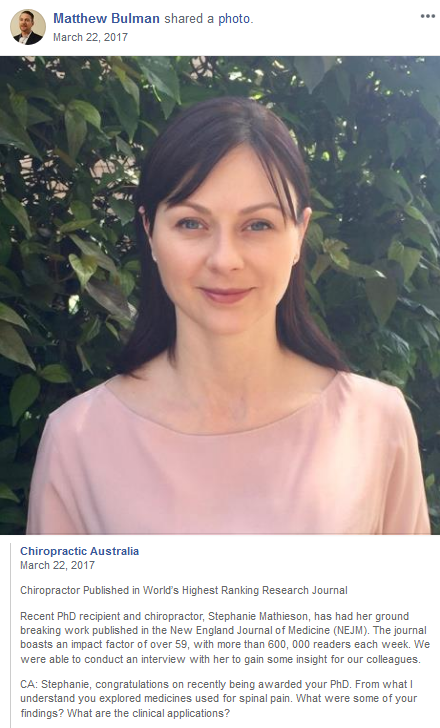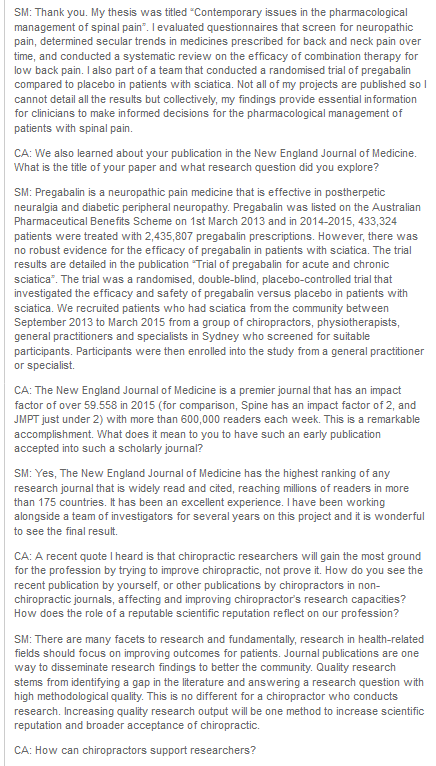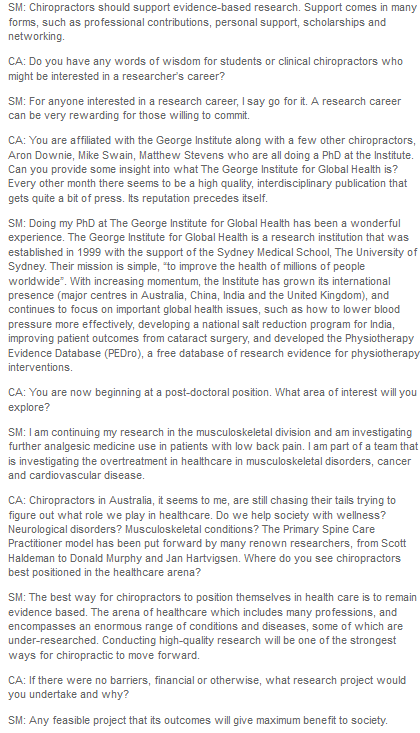Trial of Pregabalin for Acute and Chronic Sciatica
Recent PhD recipient and chiropractor, Stephanie Mathieson, has had her ground breaking work published in the New England Journal of Medicine (NEJM). The journal boasts an impact factor of over 59, with more than 600, 000 readers each week. We were able to conduct an interview with her to gain some insight for our colleagues.
CA: Stephanie, congratulations on recently being awarded your PhD. From what I understand you explored medicines used for spinal pain. What were some of your findings? What are the clinical applications?
SM: Thank you. My thesis was titled “Contemporary issues in the pharmacological management of spinal pain”. I evaluated questionnaires that screen for neuropathic pain, determined secular trends in medicines prescribed for back and neck pain over time, and conducted a systematic review on the efficacy of combination therapy for low back pain. I also part of a team that conducted a randomised trial of pregabalin compared to placebo in patients with sciatica. Not all of my projects are published so I cannot detail all the results but collectively, my findings provide essential information for clinicians to make informed decisions for the pharmacological management of patients with spinal pain.
CA: We also learned about your publication in the New England Journal of Medicine. What is the title of your paper and what research question did you explore?
SM: Pregabalin is a neuropathic pain medicine that is effective in postherpetic neuralgia and diabetic peripheral neuropathy. Pregabalin was listed on the Australian Pharmaceutical Benefits Scheme on 1st March 2013 and in 2014-2015, 433,324 patients were treated with 2,435,807 pregabalin prescriptions. However, there was no robust evidence for the efficacy of pregabalin in patients with sciatica. The trial results are detailed in the publication “Trial of pregabalin for acute and chronic sciatica”. The trial was a randomised, double-blind, placebo-controlled trial that investigated the efficacy and safety of pregabalin versus placebo in patients with sciatica. We recruited patients who had sciatica from the community between September 2013 to March 2015 from a group of chiropractors, physiotherapists, general practitioners and specialists in Sydney who screened for suitable participants. Participants were then enrolled into the study from a general practitioner or specialist.
CA: The New England Journal of Medicine is a premier journal that has an impact factor of over 59.558 in 2015 (for comparison, Spine has an impact factor of 2, and JMPT just under 2) with more than 600,000 readers each week. This is a remarkable accomplishment. What does it mean to you to have such an early publication accepted into such a scholarly journal?
SM: Yes, The New England Journal of Medicine has the highest ranking of any research journal that is widely read and cited, reaching millions of readers in more than 175 countries. It has been an excellent experience. I have been working alongside a team of investigators for several years on this project and it is wonderful to see the final result.
CA: A recent quote I heard is that chiropractic researchers will gain the most ground for the profession by trying to improve chiropractic, not prove it. How do you see the recent publication by yourself, or other publications by chiropractors in non-chiropractic journals, affecting and improving chiropractor’s research capacities? How does the role of a reputable scientific reputation reflect on our profession?
SM: There are many facets to research and fundamentally, research in health-related fields should focus on improving outcomes for patients. Journal publications are one way to disseminate research findings to better the community. Quality research stems from identifying a gap in the literature and answering a research question with high methodological quality. This is no different for a chiropractor who conducts research. Increasing quality research output will be one method to increase scientific reputation and broader acceptance of chiropractic.
CA: How can chiropractors support researchers?
SM: Chiropractors should support evidence-based research. Support comes in many forms, such as professional contributions, personal support, scholarships and networking.
CA: Do you have any words of wisdom for students or clinical chiropractors who might be interested in a researcher’s career?
SM: For anyone interested in a research career, I say go for it. A research career can be very rewarding for those willing to commit.
CA: You are affiliated with the George Institute along with a few other chiropractors, Aron Downie, Mike Swain, Matthew Stevens who are all doing a PhD at the Institute. Can you provide some insight into what The George Institute for Global Health is? Every other month there seems to be a high quality, interdisciplinary publication that gets quite a bit of press. Its reputation precedes itself.
SM: Doing my PhD at The George Institute for Global Health has been a wonderful experience. The George Institute for Global Health is a research institution that was established in 1999 with the support of the Sydney Medical School, The University of Sydney. Their mission is simple, “to improve the health of millions of people worldwide”. With increasing momentum, the Institute has grown its international presence (major centres in Australia, China, India and the United Kingdom), and continues to focus on important global health issues, such as how to lower blood pressure more effectively, developing a national salt reduction program for India, improving patient outcomes from cataract surgery, and developed the Physiotherapy Evidence Database (PEDro), a free database of research evidence for physiotherapy interventions.
CA: You are now beginning at a post-doctoral position. What area of interest will you explore?
SM: I am continuing my research in the musculoskeletal division and am investigating further analgesic medicine use in patients with low back pain. I am part of a team that is investigating the overtreatment in healthcare in musculoskeletal disorders, cancer and cardiovascular disease.
CA: Chiropractors in Australia, it seems to me, are still chasing their tails trying to figure out what role we play in healthcare. Do we help society with wellness? Neurological disorders? Musculoskeletal conditions? The Primary Spine Care Practitioner model has been put forward by many renown researchers, from Scott Haldeman to Donald Murphy and Jan Hartvigsen. Where do you see chiropractors best positioned in the healthcare arena?
SM: The best way for chiropractors to position themselves in health care is to remain evidence based. The arena of healthcare which includes many professions, and encompasses an enormous range of conditions and diseases, some of which are under-researched. Conducting high-quality research will be one of the strongest ways for chiropractic to move forward.
CA: If there were no barriers, financial or otherwise, what research project would you undertake and why?
SM: Any feasible project that its outcomes will give maximum benefit to society.
Once again, congratulations to you. And thank you for your professional contribution, adding to the evidence base.



#science #chiropractor #chiropractic #research #education #evidence based #patient centered #interprofessional #collaborative #rehabilitation #public health #spinal health #musculoskeletal health #ethics #pain #function #disability #QOL #knowledgetranslation


